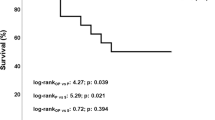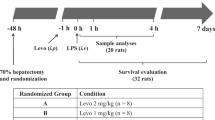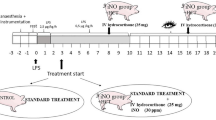Abstract
DURING the course of our investigations on the mechanism of enhanced susceptibility to endotoxin after adrenalectomy in dogs, it was found that a transferable shock-inducing factor develops in the absence of glucocorticoids. The shock induced by endotoxins which have no direct cardiovascular action has been difficult to interpret. There has been debate on the indirect mechanisms1, such as endotoxin-epinephrine synergism or histamine release. However, none could explain the effectiveness of glucocorticoids in preventing the endotoxin shock2. Concerning endotoxin susceptibility after adrenalectomy in rabbits, Fukuda3,4 has pointed out that the diminution of hepatic glycogen which follows the accumulation of endotoxin in liver might have an intimate relation to the development of circulatory weakness. Prevention of the attendant hypoglycæmia and the lactacidæmic acidosis by infusions of a hypertonic glucose and sodium bicarbonate solution has been shown to be effective in the recovery of adrenalectomized rabbits even after intravenous administration of the lethal dose of endotoxin (200 µg/kg; LD100).
This is a preview of subscription content, access via your institution
Access options
Subscribe to this journal
Receive 51 print issues and online access
$199.00 per year
only $3.90 per issue
Buy this article
- Purchase on Springer Link
- Instant access to full article PDF
Prices may be subject to local taxes which are calculated during checkout
Similar content being viewed by others
References
Gilbert, R. P., Physiol. Rev., 40, 245 (1960).
Weil, M. H., and Miller, B. S., J. Lab. and clin. Med., 57, 683 (1961).
Fukuda, T., Jap. J. Physiol., 13, 155 (1963).
Fukuda, T., and Koyama, T., Nature, 200, 1327 (1963).
Petersdorf, R. G., and Bennett, I. L., J. Exp. Med., 106, 293 (1957).
Shorr, E., Zweifach, B. W., and Furchgott, R. F., Science, 102, 489 (1945).
Weil, M. H., MacLean, L. D., Visscher, M. B., and Spink, W. W., J. Clin. Invest., 35, 1191 (1956).
Author information
Authors and Affiliations
Rights and permissions
About this article
Cite this article
FUKUDA, T., KOBAYASHI, T. & OKADA, M. Development of Shock-inducing Factor in Canine Endotoxin Shock. Nature 204, 585–586 (1964). https://doi.org/10.1038/204585a0
Issue Date:
DOI: https://doi.org/10.1038/204585a0
Comments
By submitting a comment you agree to abide by our Terms and Community Guidelines. If you find something abusive or that does not comply with our terms or guidelines please flag it as inappropriate.



